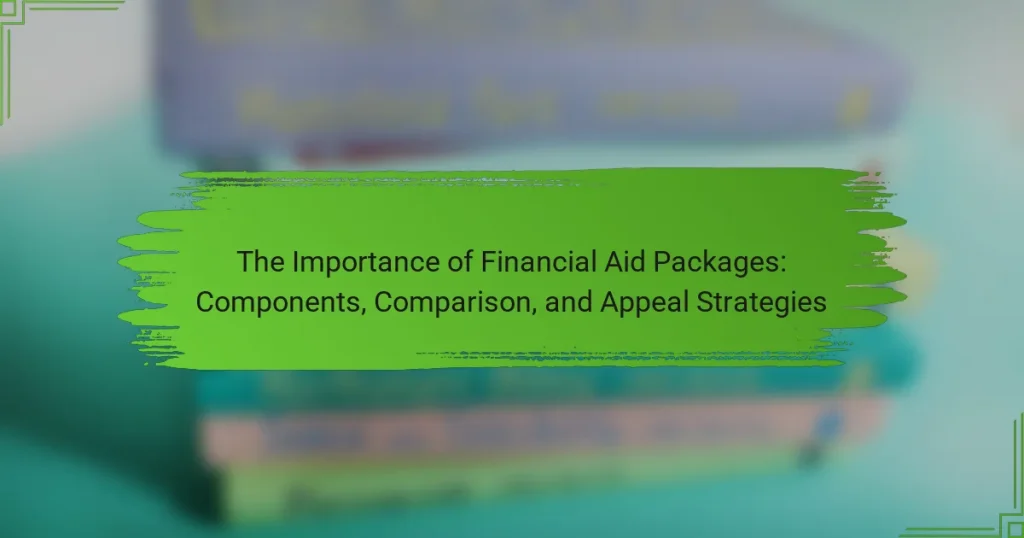
What are Financial Aid Packages and Why are They Important?
Financial aid packages are financial support offerings provided by educational institutions to help students pay for their education. These packages can include grants, scholarships, work-study opportunities, and loans. They are important because they make higher education more accessible to students from diverse financial backgrounds. According to the College Board, about 85% of full-time undergraduate students receive some form of financial aid. This support can significantly reduce the cost of attendance and lower student debt levels. Financial aid packages also encourage enrollment and retention by alleviating financial burdens.
How do Financial Aid Packages support students financially?
Financial aid packages support students financially by providing funds to cover educational expenses. These packages can include grants, scholarships, work-study opportunities, and loans. Grants and scholarships do not require repayment, significantly reducing the cost of education. Work-study programs allow students to earn money while attending school, helping to cover living expenses. Loans provide additional funding but require repayment after graduation. According to the National Center for Education Statistics, more than 70% of undergraduate students receive some form of financial aid. This support enables students to afford tuition, fees, books, and living costs, making higher education more accessible.
What are the key components of a Financial Aid Package?
A financial aid package typically includes grants, scholarships, loans, and work-study opportunities. Grants are funds that do not require repayment. Scholarships are awarded based on merit or need and also do not require repayment. Loans are borrowed funds that must be repaid with interest over time. Work-study opportunities provide part-time jobs for students to help cover educational expenses. Each component serves to reduce the overall cost of education for students. According to the National Center for Education Statistics, over 70% of undergraduate students receive some form of financial aid.
How does the financial aid process work for students?
The financial aid process for students begins with completing the Free Application for Federal Student Aid (FAFSA). This application collects financial information to determine eligibility for federal aid. Students must submit the FAFSA annually to maintain access to aid. After processing the application, schools provide a financial aid package detailing available funds. This package may include grants, loans, and work-study opportunities. Students can compare offers from different institutions. They can also appeal for more aid if their financial situation changes. The financial aid process is crucial for making education affordable.
What types of Financial Aid are available?
There are several types of financial aid available for students. These include grants, scholarships, work-study programs, and loans. Grants are funds that do not need to be repaid, often based on financial need. Scholarships are awarded based on merit or specific criteria, such as academic achievement or community service. Work-study programs provide part-time jobs for students to help pay for their education. Loans are borrowed funds that must be repaid with interest. The combination of these aids can significantly reduce the financial burden of education. According to the National Center for Education Statistics, over 70% of undergraduates receive some form of financial aid.
What are the differences between grants, scholarships, and loans?
Grants, scholarships, and loans are distinct forms of financial aid. Grants are funds awarded based on financial need that do not require repayment. Scholarships are merit-based awards that also do not need to be repaid. Loans, on the other hand, are borrowed funds that must be repaid with interest. Grants and scholarships are often funded by the government or educational institutions. Loans can be offered by banks, credit unions, or government programs. Each type of aid serves to make education more accessible but has different implications for students’ financial futures.
How do need-based and merit-based aid differ?
Need-based aid and merit-based aid differ primarily in their eligibility criteria. Need-based aid is awarded based on a student’s financial situation. This form of aid assesses the family’s income and assets to determine financial need. Common sources include federal and state grants, work-study programs, and institutional aid.
In contrast, merit-based aid is awarded based on a student’s academic, artistic, or athletic achievements. This type of aid recognizes exceptional performance in specific areas. Scholarships and awards often fall under this category.
According to the National Association of Student Financial Aid Administrators, approximately 60% of undergraduate students receive need-based aid, while about 33% receive merit-based aid. This statistic highlights the prevalence of need-based aid in supporting students financially.
What factors influence the amount of Financial Aid awarded?
The amount of financial aid awarded is influenced by several key factors. These factors include the student’s financial need, which is determined through the FAFSA application. The cost of attendance at the institution also plays a significant role. Institutions consider the expected family contribution (EFC) when determining aid. Academic merit, such as GPA and standardized test scores, can enhance aid eligibility. Additionally, the availability of institutional funds and state or federal grants affects the total aid package. Enrollment status, whether full-time or part-time, further influences the amount of aid awarded. Lastly, specific circumstances, such as being a first-generation college student or having dependent care responsibilities, may also impact aid decisions.
How do family income and assets impact Financial Aid eligibility?
Family income and assets significantly influence Financial Aid eligibility. Higher family income generally reduces the amount of aid a student can receive. Financial Aid formulas assess income to determine the Expected Family Contribution (EFC). This EFC indicates how much families are expected to contribute towards education costs.
Assets, including savings and investments, are also factored into this assessment. Families with greater assets may face reduced eligibility for need-based aid. The Free Application for Federal Student Aid (FAFSA) and the CSS Profile are key tools that evaluate these financial factors.
For instance, the FAFSA considers both taxable and non-taxable income. It also includes a portion of the family’s assets in the EFC calculation. Thus, families with lower income and fewer assets typically qualify for more financial aid.
What role do academic performance and extracurricular activities play?
Academic performance and extracurricular activities significantly influence students’ eligibility for financial aid. High academic achievement often correlates with merit-based scholarships, which reward students for their grades. For instance, many colleges offer scholarships to students with GPAs above a certain threshold. Extracurricular activities also enhance a student’s application by demonstrating leadership, commitment, and diverse interests. Research shows that students involved in extracurriculars are more likely to receive financial aid, as these activities indicate well-roundedness. Notably, the National Center for Education Statistics found that students who engage in extracurricular activities are more likely to persist in their studies, which is a factor considered by financial aid committees. Therefore, both academic performance and extracurricular involvement play crucial roles in securing financial aid opportunities.
How can students compare different Financial Aid Packages?
Students can compare different financial aid packages by analyzing several key components. They should first evaluate the total cost of attendance, which includes tuition, fees, room, and board. Next, students should identify the types of aid offered, such as grants, scholarships, loans, and work-study options. It’s important to assess the terms and conditions of loans, including interest rates and repayment plans. Students should also consider the net price, which is the total cost minus any grants and scholarships. Additionally, comparing the renewal criteria for aid is essential, as some packages may require maintaining a certain GPA. Finally, students can use online comparison tools or financial aid calculators to simplify this process. These methods ensure a comprehensive evaluation of financial aid packages, leading to informed decisions about funding education.
What should students look for when evaluating offers?
Students should look for the total cost of attendance when evaluating offers. This includes tuition, fees, room, board, and other expenses. They should also assess the types of aid offered, such as grants, scholarships, loans, and work-study options. Understanding the terms of loans is crucial, including interest rates and repayment plans. Students should compare the net price after financial aid is applied. They should evaluate the renewal criteria for scholarships and grants. Additionally, students must consider the school’s graduation rate and job placement statistics. These factors provide insight into the value of the financial aid package.
How do students assess the long-term impact of different aid types?
Students assess the long-term impact of different aid types by evaluating financial outcomes and personal experiences. They analyze how aid affects debt levels after graduation. Students also consider the influence of grants versus loans on their financial stability. Research indicates that students receiving grants report lower financial stress. Additionally, they reflect on how aid shapes their career choices and opportunities. Surveys show that aid types can impact job placement rates. Students often track their post-graduation earnings to assess the effectiveness of the aid received. This assessment process helps them make informed decisions about future financial aid applications.
What strategies can students use to appeal Financial Aid decisions?
Students can appeal Financial Aid decisions by gathering supporting documentation. This includes tax returns, medical bills, or other evidence of financial hardship. Students should write a formal letter to the financial aid office. The letter must clearly explain the reasons for the appeal. It should also include a request for a specific amount of aid.
Students should be concise and respectful in their communication. They can also request a meeting with a financial aid officer. This allows for a personal discussion of their situation. Providing additional context can strengthen the appeal. Many institutions have specific guidelines for appeals. Following these guidelines is crucial for a successful outcome.
What documentation is needed for a successful appeal?
A successful appeal typically requires specific documentation. This documentation includes a formal appeal letter outlining the reasons for the appeal. Applicants should also provide their financial information, such as tax returns and income statements. Supporting documents like medical bills or job loss notices can strengthen the case. Additionally, letters of recommendation may be beneficial. All documentation should be submitted by the institution’s deadline for the appeal process. Providing comprehensive and accurate documentation increases the chances of a successful appeal.
How can students effectively communicate their circumstances?
Students can effectively communicate their circumstances by being clear and concise in their messaging. They should outline their specific financial needs and challenges. Providing context helps institutions understand their situations better. Using relevant documentation can strengthen their case. Examples include pay stubs, tax returns, or medical bills. Students should also express their educational goals and how financial aid will help. Being honest and transparent fosters trust with aid offices. Research shows that clear communication increases the likelihood of receiving support.
What are common mistakes to avoid when dealing with Financial Aid Packages?
Common mistakes to avoid when dealing with financial aid packages include not reading the entire award letter. Many students overlook important details about deadlines and requirements. Failing to compare offers can lead to missed opportunities for better funding. Ignoring the terms of loans can result in unexpected debt. Not appealing for more aid when necessary can leave money on the table. Additionally, misunderstanding the impact of outside scholarships on aid can reduce overall funding. Lastly, neglecting to keep accurate records can complicate future applications.
How can students ensure they meet deadlines and requirements?
Students can ensure they meet deadlines and requirements by organizing their tasks effectively. They should create a detailed schedule that includes all important dates. This schedule should outline deadlines for assignments, applications, and financial aid packages. Students must prioritize tasks based on urgency and importance. They should also break larger tasks into manageable steps. Regularly reviewing their progress helps students stay on track. Additionally, seeking guidance from academic advisors can provide clarity on requirements. Utilizing reminders through digital tools can reinforce awareness of upcoming deadlines. Consistent communication with teachers and financial aid offices ensures students are informed of any changes.
What are the consequences of not understanding terms and conditions?
Not understanding terms and conditions can lead to significant negative consequences. Individuals may inadvertently agree to unfavorable terms that affect their financial obligations. This lack of understanding can result in hidden fees or penalties. For example, failing to comprehend repayment terms may lead to defaulting on loans. Additionally, consumers might miss out on important rights or protections. Misinterpretation can also result in disputes with service providers or financial institutions. Consequently, this can damage credit scores and financial stability. Ultimately, ignorance of terms and conditions can have long-lasting financial repercussions.
What best practices can enhance the Financial Aid application process?
To enhance the Financial Aid application process, applicants should start by gathering all necessary documentation early. This includes tax returns, W-2 forms, and bank statements. Completing the Free Application for Federal Student Aid (FAFSA) accurately is crucial. Double-checking for errors can prevent delays.
Using the IRS Data Retrieval Tool simplifies income verification. Applicants should also be aware of deadlines to ensure timely submission. Communicating with the financial aid office can provide clarity on specific requirements. Lastly, understanding the types of aid available helps in making informed choices.
Financial aid packages are essential financial support tools provided by educational institutions to assist students in covering the costs of their education. This article details the various components of financial aid packages, including grants, scholarships, work-study opportunities, and loans, while emphasizing their significance in making higher education accessible. It explores the financial aid process, the differences between need-based and merit-based aid, and factors influencing aid amounts. Additionally, the article outlines strategies for comparing financial aid offers and appealing decisions, highlighting common mistakes to avoid and best practices to enhance the application process.




